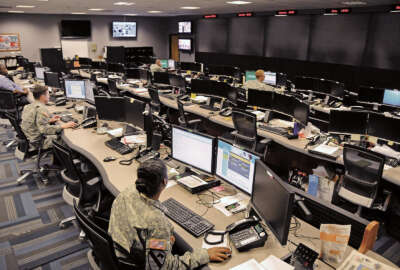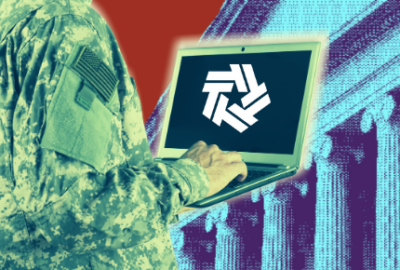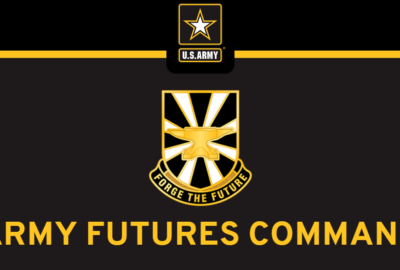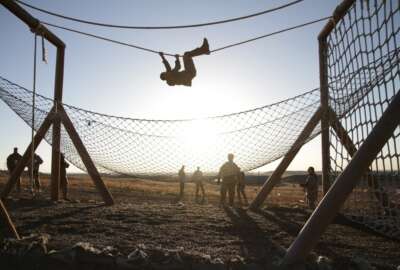Agile, adaptable, modular: The future of Army C2
The Army’s Next Generation Command and Control (NGC2) Capability Characteristics or C2Next is the roadmap for developing a different kind of command post.
For the Army, the command post of the future will need to be agile, resilient and intuitive.
It will be a big lift not only for the Army, but for the contractors who are building the technology to support it.
This is one of many reasons why the Army Chief of Staff Gen. Randy George on May 28 signed off on the Next Generation Command and Control (NGC2) Capability Characteristics (C2 Next).
The Army released a notice on SAM.gov to say the characteristics of needs are available, but vendors have to “apply” to see them as they are not public.
George and other Army senior leaders, speaking at the Army TEMS conference in Philadelphia last week, offered a preview of the characteristics, outlining key concepts and insight into what command and control of the future needs to encompass.
George said with the network being the Army’s top priority, these new characteristics are a key building block.
“I was out at the National Training Center I think it was March for Project Convergence. One of the things that I challenged everybody a year ago, and especially Army Future Command, was I want to be able to be on the network and I want us to be able to operate with tablets, phones, software-defined radios in a very simple architecture. What I saw when I was out there in March is that the technology exists now to do those kinds of things,” George said. “We had a platoon leader talking to a company commander or talking to a battalion commander talking to a brigade commander, and they were talking on tablets. All those big systems that we used to have, the Advanced Field Artillery Tactical Data System (AFATDS) is one of them, can be an app. It can be on that tablet. So rather than having a truck or two trucks and 10 people, you have an application. That’s where we have to go.”
George said the commanders were excited about these capabilities because it speeds the decision process and makes them more lethal.
Army details C2 Next
The Army developed this initial set of C2Next characteristics to support the concepts George talked about: Speed to decision, the lethality of the units, the ability to adapt and be agile based on real-time threats, challenges and needs.
Joe Welch, the director of Command, Control, Communications, Computers, Cyber, Intelligence, Surveillance, Reconnaissance Center (C5ISR) for the Army Combat Capabilities Development Command, said what’s in the characteristics are not just capabilities to build or have, but they give you the ability to tailor and adapt C2 for the commander and their staff based on their needs and information requirements. He said these characteristics aren’t even necessarily the nuts and bolts of the capabilities of systems.
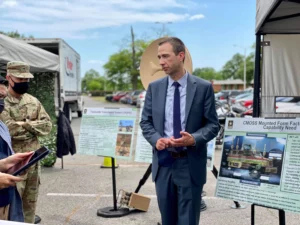
Welch outlined several focus areas for C2 Next, starting with a key ingredient agnostic transport, meaning the data gets to the users no matter the infrastructure such as cloud or satellite or on-premise data center.
“[It has to be] robust and resilient. We’ve been making lots of progress in terms of that, not just in the variety of transport paths that we have for our networks to be able to support data transmission, but to do it in an automated way and a highly secure way,” Welch said. “I see this as a continued evolution. In the characteristics of need, we talk specifically about being threat informed in this area. We started from a perspective of, we just need to be able to communicate; we need to be able to get the data where it needs to go in order to accomplish the mission.”
A second area that will be critical, Welch said, is a robust services architecture that is cloud native and based on open systems standards that let commanders easily iterate new capabilities.
“A consistent theme here recently is as-a-service. We’re seeing that in more and more areas. What’s really meant by that is that we don’t want to be fixed on any particular thing. We want to be able to experiment, prototype, move very quickly into deployment, and use something as long as it’s working, and be able to challenge it when there’s something that’s better out there when the need changes or the technology changes,” he said. “That gets into a lot more mechanics than the concepts or the capabilities that we’re describing. But it’s a very fundamental underpinning of where we’re looking to go.”
Testing C2 characteristics
Welch added C2 Next is part of a necessary and complete revamp of the way that the Army will generate, produce, consume and discover data, and it’s necessary in order to apply machine learning on to it at all.
He said if the Army wants to be able to do informed and enabled decision making much faster than the adversary, then the characteristics of need will play a huge role.
The Army has been testing many of these concepts over the last 12-18 months and improving them as it went along. Most recently at Project Convergence, an annual technology and capability demonstration, Dr. Jean Vettel, Next Generation C2 chief scientist for experimentation at Army Capabilities Command for C5ISR, said they measured some of the benefits of the C2Next characteristics.
“In the characteristics of need, you’ll see that we’ll talk a lot about modularity or…this really focus we have on composability. What does that actually mean?” Vettel said.
As an example, Vettel said commanders developing a plan to set up a command post in minutes versus hours using commercial technology called Raspberry Pis.
“Within that they had 16 Raspberry Pi’s that they put out, where they emulated the electromagnetic signature of the command post as decoys. Whenever we think about adaptability, what is the metric of adaptability that would be successful for Next C2?” she said.
The idea was to protect the command and control technologies from jamming or other cyber attacks. Vettel said this is an example of how the C2 Next characteristics emphasize adaptability.
“If it’s adaptable, that means that in the fight, whenever a pure adversary now has identified that we’re creating our decoys with electromagnetic signatures, then our warfighters need to have access to data that they couldn’t tell us they would need beforehand,” she said. “They have to have the ability to know what data they have available and how do they try to spoof or create a different decoy because they have access to the data because it’s adaptable to what they need to fight the peer adversary.”
She added this example also shows building capabilities in modules that can be plugged into, removed and changed as necessary is another key piece in the C2 Next characteristics.
A living document to be updated
C2Next characteristics are out for review and comment for industry and other folks in the Army.
Welch said the intent is to make C2 Next characteristics of need a living document that will be updated every six months or so.
Additionally, the Army Futures Command is in the early stages of planning a new contract vehicle to help bring these C2 Next characteristics into technology capabilities. While it’s still early, the Army may use an Other Transaction Authority type of approach as a way to bring multiple companies into the mix and experiment with different parts of the characteristics.
“I think what you’ll see is the characteristics of need, which may sound very principled and very large overarching statements, I’m expecting that they’re going to get iterated into some greater and greater levels of detail as we continue through Next Generation C2 experimentation,” Welch said. “We’re certainly moving fast and in alignment with the chief’s objective to be moving with speed and urgency. We’re going to be moving in conjunction with our partners at Acquisition, Logistics and Technology (ASA(ALT) as we look beyond experimentation and prototyping and into delivery of Next Generation C2 capability.”
Copyright © 2025 Federal News Network. All rights reserved. This website is not intended for users located within the European Economic Area.
Jason Miller is executive editor of Federal News Network and directs news coverage on the people, policy and programs of the federal government.
Follow @jmillerWFED




